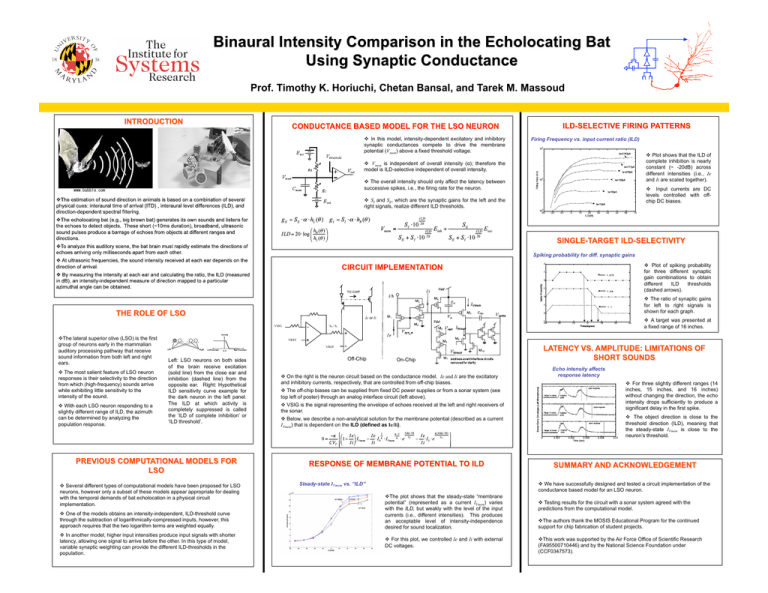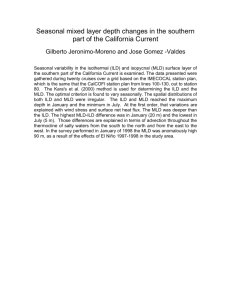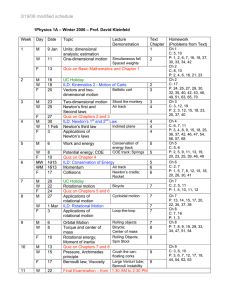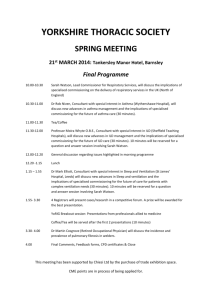Prof. Timothy K. Horiuchi, Chetan Bansal, and Tarek M. Massoud
advertisement

Prof. Timothy K. Horiuchi, Chetan Bansal, and Tarek M. Massoud In this model, intensity-dependent excitatory and inhibitory synaptic conductances compete to drive the membrane potential (Vmem) above a fixed threshold voltage. Firing Frequency vs. input current ratio (ILD) Plot shows that the ILD of complete inhibition is nearly constant (~ -20dB) across different intensities (i.e., Ie and Ii are scaled together). Vmem is independent of overall intensity (α); therefore the model is ILD-selective independent of overall intensity. The overall intensity should only affect the latency between successive spikes, i.e., the firing rate for the neuron. www.babble.com Input currents are DC levels controlled with offchip DC biases. SI and SE, which are the synaptic gains for the left and the right signals, realize different ILD thresholds. Spiking probability for diff. synaptic gains Plot of spiking probability for three different synaptic gain combinations to obtain different ILD thresholds (dashed arrows). TO CHIP The ratio of synaptic gains for left to right signals is shown for each graph. Ie or Ii The lateral superior olive (LSO) is the first group of neurons early in the mammalian auditory processing pathway that receive sound information from both left and right ears. The most salient feature of LSO neuron responses is their selectivity to the direction from which (high-frequency) sounds arrive while exhibiting little sensitivity to the intensity of the sound. With each LSO neuron responding to a slightly different range of ILD, the azimuth can be determined by analyzing the population response. A target was presented at a fixed range of 16 inches. SE / SI VSIG VREF VREF Left: LSO neurons on both sides of the brain receive excitation (solid line) from the close ear and inhibition (dashed line) from the opposite ear. Right: Hypothetical ILD sensitivity curve example for the dark neuron in the left panel. The ILD at which activity is completely suppressed is called the ‘ILD of complete inhibition’ or ‘ILD threshold’. Several different types of computational models have been proposed for LSO neurons, however only a subset of these models appear appropriate for dealing with the temporal demands of bat echolocation in a physical circuit implementation. One of the models obtains an intensity-independent, ILD-threshold curve through the subtraction of logarithmically-compressed inputs, however, this approach requires that the two logarithm terms are weighted equally. In another model, higher input intensities produce input signals with shorter latency, allowing one signal to arrive before the other. In this type of model, variable synaptic weighting can provide the different ILD-thresholds in the population. Off-Chip On-Chip On the right is the neuron circuit based on the conductance model. Ie and Ii are the excitatory and inhibitory currents, respectively, that are controlled from off-chip biases. The off-chip biases can be supplied from fixed DC power supplies or from a sonar system (see top left of poster) through an analog interface circuit (left above). VSIG is the signal representing the envelope of echoes received at the left and right receivers of the sonar. Below, we describe a non-analytical solution for the membrane potential (described as a current IVmem) that is dependent on the ILD (defined as Ie/Ii). Steady-state IVmem vs. “ILD” Echo intensity affects response latency For three slightly different ranges (14 inches, 15 inches, and 16 inches) without changing the direction, the echo intensity drops sufficiently to produce a significant delay in the first spike. The object direction is close to the threshold direction (ILD), meaning that the steady-state IVmem is close to the neuron’s threshold. We have successfully designed and tested a circuit implementation of the conductance based model for an LSO neuron. The plot shows that the steady-state “membrane potential” (represented as a current IVmem) varies with the ILD, but weakly with the level of the input currents (i.e., different intensities). This produces an acceptable level of intensity-independence desired for sound localization. For this plot, we controlled Ie and Ii with external DC voltages. Testing results for the circuit with a sonar system agreed with the predictions from the computational model. The authors thank the MOSIS Educational Program for the continued support for chip fabrication of student projects. This work was supported by the Air Force Office of Scientific Research (FA95500710446) and by the National Science Foundation under (CCF0347573).








